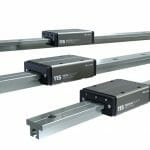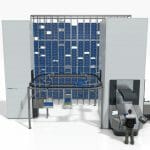The railways in the United Kingdom are among the busiest in Europe and with growth in demand from both passenger and freight services over the last 20 years, large parts of the rail network at capacity. This constrained capacity means that any disruption to the rail timetable can lead to extensive and expensive delays. Reliability of both rolling stock and infrastructure becomes ever more important and companies continue to look at ways of improving the reliability of their assets.
The Class 66 diesel-electric locomotive, manufactured by Electro-Motive Diesel in the USA, is one of the most widely used locomotives in the United Kingdom, primarily for freight use with a total of 455 produced.
Each locomotive is specified and guaranteed to 95% availability, with a target of a minimum of 180 days mean time between failures and to have the ability to cover 1.6 million km between major rebuilds, the equivalent to 18 years of service.
With 3,300 bhp being generated from its V12 two-stroke diesel, the locomotive has proven to have a high reliability which has helped the rail freight companies to remain competitive.
However, there was one recurring problem that compromised the high reliability of the locomotive and that was low coolant levels, which led to the locomotive shutting down, wherever it was. Not only did this mean that another locomotive needed to be sent to recover the train, it also caused considerable delays and potential costly damage to the engine itself, with subsequent unavailability whilst undergoing repairs.
The coolant tank was fitted with a sight gauge at manufacture on the side of the tank, so that a quick visual inspection could be undertaken each day before the locomotive was used.
There were two problems with this, however- over a period of time the sight gauge would become obscured with build-up from the water and additives used in the coolant system, making it hard to read. This was further compounded by the fact that the engine compartment is very crowded and difficult to access because of low light levels.
These factors combined to make it very difficult to read the coolant level in the sight glass accurately, such that either a reading was not taken, or that it was simply not possible to see the fluid level was low. This led to the locomotive shutting down unexpectedly in service, causing the problems described earlier.
Clearly, a solution was required to cure this problem and the answer was to provide an indication in the cab so that the driver could see on starting the locomotive, or during operation, that the coolant level was low.
Because of the high utilisation of the locomotives and the extended service periods, a sensor was required that would remain operational and accurate over prolonged periods without maintenance, and be unaffected by the high levels of vibration and heat experienced in service.
Gill Sensors & Controls was approached because it offered durable and accurate capacitive liquid level sensors. The sensors are designed using solid-state technology with no moving parts and a tolerance of high temperatures which gives these sensors the reliability to meet the service specification of the locomotive.
Gill Sensors & Controls created a customised version of their standard 7010 industrial level sensor to meet the application requirements.
The sensor is manufactured from stainless steel at 450mm in length, with an extended 2 metre flying lead with low smoke and toxicity characteristics to meet fire regulations. The flange was also changed to remove the threaded portion to a plain 1” diameter, allowing fastening using the 5 hole SAE fitting. The sensor has a 4-20mA output.
“The adoption of the Gill sensor to monitor the coolant levels has provided certainty and prevented many unnecessary breakdowns caused by a locomotive going out with insufficient coolant” says Simon Peaty, Product Manager. “The fact that we only had to make simple modifications to a standard sensor to meet the specific needs of the installation is testament to the inherent quality and performance of our level sensor product range”.





